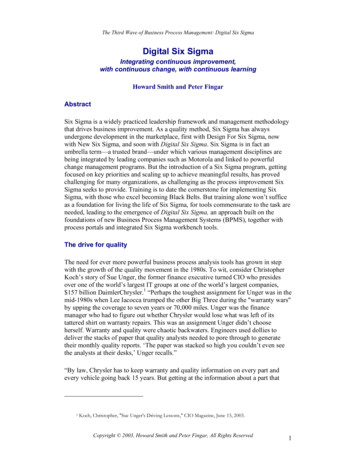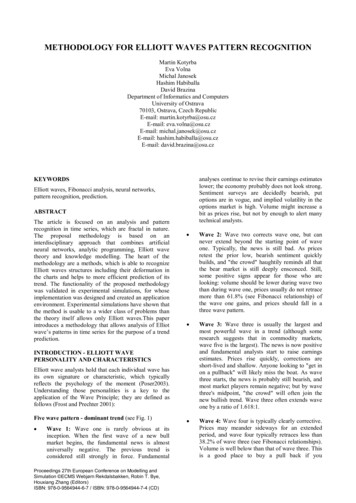
Transcription
The Third Wave of Business Process Management: Digital Six SigmaDigital Six SigmaIntegrating continuous improvement,with continuous change, with continuous learningHoward Smith and Peter FingarAbstractSix Sigma is a widely practiced leadership framework and management methodologythat drives business improvement. As a quality method, Six Sigma has alwaysundergone development in the marketplace, first with Design For Six Sigma, nowwith New Six Sigma, and soon with Digital Six Sigma. Six Sigma is in fact anumbrella term—a trusted brand—under which various management disciplines arebeing integrated by leading companies such as Motorola and linked to powerfulchange management programs. But the introduction of a Six Sigma program, gettingfocused on key priorities and scaling up to achieve meaningful results, has provedchallenging for many organizations, as challenging as the process improvement SixSigma seeks to provide. Training is to date the cornerstone for implementing SixSigma, with those who excel becoming Black Belts. But training alone won’t sufficeas a foundation for living the life of Six Sigma, for tools commensurate to the task areneeded, leading to the emergence of Digital Six Sigma, an approach built on thefoundations of new Business Process Management Systems (BPMS), together withprocess portals and integrated Six Sigma workbench tools.The drive for qualityThe need for ever more powerful business process analysis tools has grown in stepwith the growth of the quality movement in the 1980s. To wit, consider ChristopherKoch’s story of Sue Unger, the former finance executive turned CIO who presidesover one of the world’s largest IT groups at one of the world’s largest companies, 157 billion DaimlerChrysler.1 “Perhaps the toughest assignment for Unger was in themid-1980s when Lee Iacocca trumped the other Big Three during the "warranty wars"by upping the coverage to seven years or 70,000 miles. Unger was the financemanager who had to figure out whether Chrysler would lose what was left of itstattered shirt on warranty repairs. This was an assignment Unger didn’t chooseherself. Warranty and quality were chaotic backwaters. Engineers used dollies todeliver the stacks of paper that quality analysts needed to pore through to generatetheir monthly quality reports. ‘The paper was stacked so high you couldn’t even seethe analysts at their desks,’ Unger recalls.”“By law, Chrysler has to keep warranty and quality information on every part andevery vehicle going back 15 years. But getting at the information about a part that1Koch, Christopher, "Sue Unger's Driving Lessons," CIO Magazine, June 15, 2003.Copyright 2003, Howard Smith and Peter Fingar, All Rights Reserved1
The Third Wave of Business Process Management: Digital Six Sigmafailed last week was as difficult as finding one that blew up 10 years ago. Ungerrealized that if warranty and quality data went online, the engineers would be able tofix the quality problems much quicker. Naïveté about technology may have been ablessing in disguise. ‘IT said it was impossible to put this much information in adatabase, much less analyze it,’ Unger recalls. Persistence won, and Unger finally gotthe database technology she needed.”Considering that Unger’s warrantee problem was but one specific instance, multiplyher requirements across DaimlerChrysler today, and then again across a supply chainextended across the globe. The papers stacked on analyst’s desks to accomplish thesetasks would so high as to rival Mt. Everest! While the need for quality programs, hasnever been more pressing, the need for commensurate tools is clear. While Six Sigmarepresents the latest evolution in quality methods, the silos of information systemsscattered across entire value chains create an immense challenge. IT is, once again, inthe unenviable position of having to say that the challenge is impossible. Yet,solutions indeed must be found. While data-oriented analytical systems are acommodity available to Six Sigma practitioners, process management systems arenow emerging as powerful foundations for digitizing Six Sigma and applying it inever more complex business situations and environments—the coming Digital SixSigma.A retrospective for those new to Six SigmaThe cornerstone of the traditional Six Sigma method is the DMAIC processimprovement lifecycle—Define, Measure, Analyze, Improve and Control. Statisticalmethods are used to identify, root out and eradicate deviations, defects and other typesof deficiencies in processes. Practitioners identify the most promising pressure pointsthat can be applied to processes in order to drive their improvement. It relies upon asmall number of key best practices that can be taught and practiced in any businesscontext: Critical to quality: Attributes the customer values most. Defect: Failure to deliver what the customer expects. Process capability: What a process can deliver. Variation: What the customer sees and feels. Stable operations: Ensuring consistent, predictable processes toimprove what the customer sees and feels. Design for Six Sigma: Designing to meet customer needs and processcapability.Here is an example of DMAIC processes from GE Capital: Define the customer, what their Critical to Quality (CTQ) issues are, and theCore Business Process involved. Define who customers are, what theirCopyright 2003, Howard Smith and Peter Fingar, All Rights Reserved2
The Third Wave of Business Process Management: Digital Six Sigmarequirements are for products and services, and what their expectations are.Define project boundaries—the stop and start of the process. Define theprocess to be improved by mapping the process flow. Measure the performance of the Core Business Process involved.Develop a data collection plan for the process. Collect adequate data frommany sources to determine types of defects and metrics. Compare withcustomer survey results to determine shortfall. Analyze the data collected and the process map to determine the root causes ofdefects and identify opportunities for improvement. Identify gaps betweencurrent performance and goal performance. Prioritize opportunities toimprove. Identify sources of variation. Improve the target process by designing creative solutions for fixing andpreventing defects. Create innovative solutions using technology anddiscipline. Develop and deploy an implementation plan. Control the improvements to keep the process on its new course.Prevent reverting back to the “old way.” Require the development,documentation and implementation of an ongoing monitoring plan.Institutionalize the improvements through the modification of systems andstructures (staffing, training and incentives).The Evolution of Six SigmaWhile Six Sigma’s roots lie in statistical deviation analysis applied to variations inmanufacturing process performance, the same statistical techniques are now beingapplied more broadly within the business—and across a much wider variety ofbusiness processes than its roots in manufacturing quality might indicate. Today, SixSigma is applied even in areas of the business traditionally thought to be devoid ofprocess, such as creative design, marketing and business development. To meet thatneed, Six Sigma now embraces a portfolio of various “best practices” including Voiceof the Customer (VOC), Balanced Scorecard, High-Performance Teams, Black BeltTeams, TRIZ and Dashboards. These methods and tools help Six Sigma practitionersfocus on the most effective metrics that can be analyzed using Six Sigma’s traditionalstatistical methods.Six Sigma black belts are skilled in precisely defining DMAIC processes and thendeveloping effective ways to apply them so that they work in practice across theorganization. They work with Six Sigma team members, many of which are theemployees involved in the processes to be improved. They develop approaches thataccommodate process change in situations where those impacted don’t have the time,or inclination, to think or act in terms of processes. Indeed, for many in business thevery word “process” is an anathema—overloaded with negative connotations from theera of disruptive reengineering and prescriptive workflows.Copyright 2003, Howard Smith and Peter Fingar, All Rights Reserved3
The Third Wave of Business Process Management: Digital Six SigmaThese new Six Sigma methods stress organizational alignment on goals, objectives,priorities, targets, actions and the orthogonal alignment between needs, skills,competencies and assets. New Six Sigma is Motorola’s umbrella under which updatedSix Sigma techniques are applied more broadly (end-to-end) within the corporation.Modern Six Sigma practitioners, such as Motorola’s Matt Barney, aim to integratekey disciplines from Finance, Engineering, Strategy, Statistics, Tangible andIntangible Asset Management, IT and Industrial-Organizational Psychology. His workand that of his colleagues in the Six Sigma community will radically re-define SixSigma over the coming years. The focus of the New Six Sigma method is away fromsimply reducing defects and towards reducing variation around accomplishingbusiness goals. At Motorola, Six Sigma has evolved from a metric process to aculture.Figure 1 – The Evolution of Six SigmaTools for Six SigmaTraditionally, Six Sigma practitioners have used only discrete productivity tools, suchas drawing packages, spreadsheets, statistics packages and personal or workgroupdatabases—they have built their own Six Sigma processes around these tools. Theyuse techniques such as FMEA, C&E Matrix, SIPOC and associated diagrams,including CT-Trees, Fishbone diagrams and Process maps. Six Sigma practitionersalso rely upon templates for project selection, prioritization and charter definition aswell as the application of project planning tools to create plans for process control,audit and data collection. Bringing all of these methods together, and integrating theSix Sigma information across them, can be daunting. For this reason, new Six Sigmatools are emerging in the marketplace.Microsoft supplies a Six Sigma solution, but it hardly represents a major innovation.Microsoft has integrated existing tools such as Project, Excel and Access using VisualBasic scripts to provide a basic Six Sigma working toolset. The perceived weakness insuch an approach has led others to go further. For example, SigmaFlow provides adedicated, integrated, purpose-built environment in which to conduct Six Sigmaprojects. But such productivity tools, even though they are a major advance, do notclose the loop to process execution. What Six Sigma practitioners want to do is insertnew quality processes directly into live operations and use them to control thelifecycle of process improvement. For this reason some companies are experimentingwith the integration of Six Sigma tools with various kinds of business processmanagement (BPM) solutions.Copyright 2003, Howard Smith and Peter Fingar, All Rights Reserved4
The Third Wave of Business Process Management: Digital Six SigmaOne example is SigmaFlow’s announcement of an alliance with workflow/BPMvendor Metastorm. In addition, BPM vendors are also adapting their own solutionstoward Six Sigma. For example, Action Technologies uses coordination andnegotiation processes to measure the effectiveness of teamwork as a Six Sigmametric.While valuable, these point solutions only hint at the potential of the coming DigitalSix Sigma. Will individual vendors such as SigmaFlow be required to create allianceswith, and technical interfaces to, each of the numerous execution environments withinthe typical enterprise, including different workflow solutions, ERP, SCM, CRM EAIand application server? Can what Action Technologies has achieved be appliedoutside of the specific human-human collaboration processes it supports so well?Neither of these approaches is yet based on the principles of business processdigitization and they will not deliver the potential of systemic Digital Six Sigma.Digital Six SigmaDigital Six Sigma is the systemic use of information technology (beyond separatestatistics packages, spreadsheets and knowledge tools) to close the loop between endto-end business process design, and execution and optimization. The foundation forDigital Six Sigma implementation is the Business Process Management System(BPMS)—the process engine linking tangible and intangible assets (people,processes, systems, knowledge) horizontally across all participants in a value chain,and vertically from business strategy to IT implementation.BPMS vendors provide a process lifecycle orthogonal to today’s software engineeringlifecycle. They support business process modeling languages (such as BPML2, anextension of BPEL) and provide the lingua-franca across disparate processes, processimprovement methodologies, tools and notations. Such an approach goes far beyondthe import/export capabilities for processes currently provided in some processmodeling tools. The BPMS provides a process platform on which process modelingand analysis tools, including those for Six Sigma, can be integrated.The BPMS provides process projection and consolidation of numerous technologiesand tools already in the enterprise. Each technology and the processes it provides canparticipate in end-to-end Digital Six Sigma processes modelled using the designdriven-architecture (DDA) principles inherent in the BPMS. The emphasis is on themodeling of end-to-end process behavior, providing a complete process lifecycle.In addition to the business processes brought under the purview of the BPMSplatform, Six Sigma, itself a process, can be built-in. Digital Six Sigma takes changeoff the critical path to performance and innovation by integrating continuousimprovement, with continuous change, with continuous learning—and goes far2www.bpmi.orgCopyright 2003, Howard Smith and Peter Fingar, All Rights Reserved5
The Third Wave of Business Process Management: Digital Six Sigmabeyond discrete Six Sigma productivity tools. Discrete tools such as SigmaFlow cannevertheless be integrated with the BPMS. And process collaboration tools providedby companies such as Action Technologies and Metastorm can play a role in the endto-end processes created. For example, each can be the vehicle for exposing the newprocesses directly to end-users.Figure 2 – Process Consolidation Using BPMSBPM is pervasive but practice and terminology variesThe research firm, Metagroup, reported that Global 2000 organisations are almostuniversally embarking on multiple process improvement exercises to increaseorganizational efficiency and effectiveness. These efforts go by many names,including industrial engineering, ISO certification, Six Sigma, enterprise businessarchitecture (EBA), business process improvement (BPI), business process reengineering (BPR), Rummler-Brache Performance Improvement, IntegratedDefinition Function Modeling (IDFM) and lean thinking, to name a few. Supportingthese process improvement initiatives are a wide variety of process notations andmethods, including entity relationship diagrams, ANSI standard flowcharts, processmaps of various types, data flow diagrams, Unified Modeling Language (UML)diagrams (activity, class, etc.), Catalyst, LOVEM, network diagrams, CRUD (create,read, update, and delete) matrices, IDEF charts (0 through 9) and EPCs (eventchains). When the founders of the Business Process Management Initiative(BPMI.org) first met in 1999, they asked a simple question: could there be somethingin common to each of these improvement initiatives, notations and methods? Theanswer surprised all of us.Copyright 2003, Howard Smith and Peter Fingar, All Rights Reserved6
The Third Wave of Business Process Management: Digital Six SigmaBPMI.org found a way to represent all business processes that parallels thesignificance of the relational data model for business data. The group were alsosuccessful in developing a methodology for processes that could accommodate theexpression of diverse business improvement methods. They are nothing more thanprocesses participating in other processes. Through this work the door opened towardsthe era of BPMS, as the development of the relational model opened the door toRDBMS.Just as enterprise data management depends upon the RDBMS capability, Digital SixSigma depends upon the BPMS capability—a digital process platform that canimplement a complete process lifecycle. Six Sigma practitioners already understandthe need for this process lifecycle. They have been implementing this lifecycle in theirbusinesses for years, but using manual techniques and piecemeal digital tools. Onlynow with the emergence of the BPMS are means available to implement the processlifecycle across the existing IT infrastructure and in the design of new processes.The Digitized Business ProcessBusiness processes are not only about the flow of documents, work items or thetechnical integration of applications or Web services. They are mainly concerned withcoordinating the end-to-end collaborative and transactional activities that bring valueto customers. While computational activities are well understood and modelled incomputer systems, the communication links between discrete computational elementsof information systems have been lacking formal underpinnings. In other words, eachcomputational element can provide a capability, but it is the linking of such discretecapabilities through communication that provides the overall capability of theinformation system—the whole being greater than the sum of the discrete parts.The BPMS uses the principles of Pi Calculus3 to unify our view of communicationand computation at all levels into a single paradigm. A BPMS can be thought of as acommunication back-plane where plug and play process capabilities (including SixSigma processes) can be implemented and managed as a unified whole, breakingdown the artificial distinctions inherent in stovepipe processes in systems andpractices. The end-to-end model of process that BPMS enables is similar to the endto-end data model that the relational model of data enabled. Pi Calculus is a newfoundation for computing that does not distinguish between the computing parts andthe communicating parts. Pi Calculus provides a new representation for processes inwhich all computation can be viewed as communication and all communication canbe viewed as computation. Quite literally, in the Pi Calculus, there is no distinctionbetween computation and communication. In implementations of languages such asBPML which are based on the Pi Calculus, this provides the following benefits: 3Distinctions between business logic, software code and data flow vanish,exposing the real process to business people in a way they can -process.pdfCopyright 2003, Howard Smith and Peter Fingar, All Rights Reserved7
The Third Wave of Business Process Management: Digital Six Sigma Distinctions between processes and what processes process, vanish.Everything is a process and the results of all processes can be consideredprocess data amenable to analysis by other processes (Analogy for networks:Internet Protocol (IP) over everything and everything over IP) Workflows are connected into multi-participant processes and visualised usingrole/activity/swimlane-type diagrams. Distinctions between workflow casesand workflow processes vanish. The case is the process. The process is a newform of digital content. Nested transactions and processes can be implementedacross an end-to-end view of process participants. Processes are free to evolvein line with the business as controlled evolutions of their starting design.Using the principles of Pi Calculus, the BPMS can represent end-to-end processes—past, present and future state—horizontally across the company so that all participantscan be involved, and vertically from the highest expression of business strategy to themost intricate details of process execution. The BPMS digitizes our view of theenterprise end-to-end, as RDBMS digitizes our view of business data.Digital Six Sigma requires the capability to manage, in combination, all thecharacteristics inherent in business processes: Automational, eliminating human labor from a process, or reinforcing humanprocesses with automational support Informational, capturing process information for purposes of understanding Sequential, changing process sequence, or enabling parallelism Tracking, closely monitoring process status and participants Analytical, improving analysis of information and decision-making acrossprocesses Geographical, coordinating processes across distances Instrumented, measuring, touching and sensing process performance Integrative, consolidating and integrating sub-processes and tasks Intellectual, the process of capturing and distributing intellectual assets Disintermediating, eliminating intermediaries from a process Computational, performing calculations as part of a distributed process Collaborative, allowing participants to manage sets of shared work processes Compositional, building new processes from elementary reusable processpatternsCopyright 2003, Howard Smith and Peter Fingar, All Rights Reserved8
The Third Wave of Business Process Management: Digital Six SigmaDigital Six Sigma InfrastructureWe define Digital Six Sigma as the implementation of the Six Sigma processes usingthe BPMS. The BPMS provides the foundation upon which to build a collaborative,consolidated, enterprise-wide environment for the conduct of comprehensive SixSigma initiatives. The objective is to accelerate results from Six Sigma investmentsby providing a tangible (executable) Six Sigma Process Lifecycle Model. Such amodel supports the key Six Sigma objectives of process alignment, mobilization,acceleration and governance.Think of the BPMS as the engine we can use to examine the behaviour of allprocesses, not in terms of how they are implemented in discrete subsystems, but interms of how they behave, based on observation of the interactions betweenparticipants at all levels. The central component of the BPMS that is able to do this iscalled a process virtual machine, the component that implements the Pi Calculus. TheBPMS also contains projectors that allow existing computing elements such as ERP,portals and dashboards to be included in processes.With Six Sigma built in, the BPMS can be predictive, self-correcting, visible anddynamic. The BPMS provides the end-to-end view of processes—past, present andfuture—creating the process data as processes execute that make it possible to supportthe distributed Six Sigma team through a process portal that encourages collaborationthrough coordination, commitments and negotiation processes.Figure 3 – The Role of Process Portals and BPMS in Digital Six SigmaThe BPMS establishes a domain-specific process repository and live processdeployment in the distributed enterprise-computing environment. The BPMSconsolidates, describes and includes all the key process participants (e.g., people,systems, machines, other processes, Six Sigma processes) across the value chain, endto-end. Leading organizations such as Motorola, the inventors of Six Sigma, arealready at work developing frameworks for various kinds of Digital Six Sigma.Copyright 2003, Howard Smith and Peter Fingar, All Rights Reserved9
The Third Wave of Business Process Management: Digital Six SigmaThe Digital Six Sigma ProcessSix Sigma comprises a set of interlinked processes for Definition, Measurement,Analysis, Improvement and Control. There are also New Six Sigma processes forAlignment, Mobilization, Acceleration and Governance. These processes cannot bepackaged in the form of software applications; they must be modeled and executed inthe unique circumstances of each company, and that’s precisely where the BPMS fitin, because: The design of the processes must reflect how the company wishes to competein the marketplace and how it wishes to improve its operations, products andservices, and; End-to-end processes must map onto and consolidate the processes supportedby the existing IT infrastructure, the hundreds of systems the company relieson, and how these have been deployed and customized, and; They must reflect the unique ways in which the firm wishes to pursue SixSigma quality, taking into account numerous practical factors in the business.Using a BPMS to link business processes to Six Sigma quality objectives creates a farmore pervasive and symbiotic relationship between the Six Sigma program and thebusiness. Technically, the Six Sigma processes participate one within another andwith the business processes they improve. The BPMS supports the “white space”between all processes. It defines the interfaces between and among processes. Theseprocess boundaries and the information flows across them create the measurementpoints where Six Sigma statistical methods can be applied, for Digital Six SigmaBPMS provides: A shared language for the expression of all processes (Six Sigma processesand other business processes) Executable processes, and a live process deployment environment that is ableto express end-to-end processes which include all key participants Six Sigma data collection that can be automated using processes; the data isthe exchange of information between participants in the process Executable processes that provide audit trails and a persistent store of processinteractions for Six Sigma analysis A process query language, providing the foundation for numerous, custom SixSigma dashboards as participants in the process Processes that can encode Six Sigma specific metrics enabling real-time SixSigmaCopyright 2003, Howard Smith and Peter Fingar, All Rights Reserved10
The Third Wave of Business Process Management: Digital Six Sigma Process portals that automatically adjust to new Six Sigma process designs,mobilizing employees to use such new processes Autonomous Six Sigma processes that can be directly executed, streamliningthe Six Sigma effort, enabling efficient knowledge transfer between Six Sigmapractitioners and business leaders Simulation that can be an active component, simulating new process design orproviding simulation-enhanced processes (simulation as a process participant)Source: Computer Sciences CorporationFigure 4 – Conceptual Design for a Digital Six Sigma InfrastructureApplying Digital Six SigmaInstances of Digital Six Sigma processes proceed from design to execution with norequirement for traditional software development. The BPMS provides a processengineering environment that puts process at the heart of the architecture, openingprocess manipulation for business improvement just as CAD/CAM put 3-D models atthe center of product design, opening the possibility for computer-integratedmanufacturing. Digital Six Sigma is CAD/CAM for business processes. It creates ashared environment for process design and a path to execution, closing the loop fromstrategy to operations. Actions required for process improvement are made visible toeveryone in the extended enterprise, accelerating adoption across business units andbusiness partners. Here are examples:BPMS facilitates the DMAIC process in at least the following ways:Copyright 2003, Howard Smith and Peter Fingar, All Rights Reserved11
The Third Wave of Business Process Management: Digital Six Sigma Define activity. BPM languages help express the process under study. Theprocess can be described in as much or as little detail as required—from thefinest details of implementation to the highest-level abstract expression of abusiness model design. It is directly executable with no further steps. Measure activity. An executable process can express the DMAIC datacollection plan precisely, whether it involves analysis of a single element or ofmany elements from across multiple systems. It can immediately collect datafrom operational systems and work patterns in a fully automated manner andon a regular basis. Metrics data will be complete, accurate and timely. Thiswill provide a true business activity monitoring (BAM) as opposed to thederivation from the “after-the-fact” results of static data analysis, or theindirect results of observing technical messages on an enterprise network. Analyze activity. An executable process can encode metrics within any processdesign so that the comparison of variations in current performance againststated goals can be readily derived. The BPMS maintains the lifecycle of theend-to-end state, structure and design of the processes under study, and can bequeried by existing tools. Executable processes can encode the calculation ofthe Six Sigma metric itself in terms meaningful to a particular industry—defects in products, uptime on a power grid, reported telecommunicationsfaults, ability to supply, and so on. Improve activity. The BPMS can assist Six Sigma practitioners in thegeneration and exploration of alternate process designs, in conjunction withsimulation. Simulation can be added to processes as a participant. Control activity. The BPM approach helps prevent revised processes revertingto the “old way” by adjusting the human interface of process systems to reflectchanging process design. Process portals and a process desktop expediteknowledge transfer related to new processes by keeping employees totallyinvolved in and interacting with the evolving digital process.ConclusionTo the old adage, “you cannot improve that which you cannot measure,” we add, “youcannot effectively measure that which you cannot digitize.” Bringing organizations tothe state of excellence in today’s global markets demands unprecedented requirementsfor speed and customization that only business process management systems candeliver. If organizations adopt an ad-hoc approach to Six Sigma, they will re-inventthe wheel in every improvement project. On the other hand, analysts like Gartner andothers have shown how workflow, rules and BPM speeds the impl
Jun 15, 2003 · Six Sigma is a widely practiced leadership framework and management methodology that drives business improvement. As a quality method, Six Sigma has always undergone development in the marketplace, first with Design For Six Sigma, now with New Six Sigma, and soon with Digital Six











